1.队列
1.1队列的概念和结构
今天我们要是实现的队列是完全相反的,队列是数据先进先出。而在栈中我们使用的顺序表(数组)来实现的。而队列却用单链表来实现是更加合适的。
队列:只允许在一端进行插入数据操作,在另一端进行数据操作的特殊线性表,队列具有先进先出FIFO(Frist in First out)。
入队列:进行插入操作的一端称为队尾
出队列:进行删除操作的一端称为队头

这里我们举个例子:在我们食堂买饭的时候,你付完钱商家都会给你一个号码,等叫到你号时就可以去领饭,以免被人插队,先买的就会先被叫到号,而队列就是秉持这样一个原则,先入先出的性质。

由于队列要进行尾插头删操作,所以我们可以再定义一个结构体来保存队列的头指针和尾指针。队列的大小最好也保存一下。因为我们想要进行入队列出队列操作时,只需要通过队列的头指针和尾指针就可以进行尾插头删操作。
下面上代码讲解:
typedef int QDataType;
typedef struct QueueNode
{
struct QueueNode* next;
QDataType data;
}QNode;
typedef struct Queue
{
QNode* phead;
QNode* ptail;
int size;
}Queue;
void QueueInit(Queue* pq);
void QueueDestroy(Queue* pq);
void QueuePush(Queue* pq, QDataType x);
void QueuePop(Queue* pq);
QDataType QueueFront(Queue* pq);
QDataType QueueBack(Queue* pq);
int QueueSize(Queue* pq);
bool QueueEmpty(Queue* pq);
2.1 初始化和销毁队列
这里我们实现的单链表是无头不循环的单链表。所以我们把队列头和队列尾初始化为空指针。
而队列的销毁跟我们之前所学的都是一样的,每次记录下一个头节点位置,把头节点释放掉,直到为空为止。
void QueueInit(Queue* pq)
{
assert(pq);
pq->phead = NULL;
pq->ptail = NULL;
pq->size = 0;
}
void QueueDestroy(Queue* pq)
{
assert(pq);
QNode* cur = pq->phead;
while (cur)
{
QNode* next = cur->next;
free(cur);
cur = next;
}
pq->phead = pq->ptail = NULL;
pq->size = 0;
}2.2 队列的尾入
这里我们分两种情况:
第一种:第一次尾入数据的时候,新节点就是队列的尾和队列的头,把新结点赋值给队列的头和队列的尾。
第二种:队列已经有数据了,我们把新的结点链接到尾后面,然后再把新结点赋值为新的结点,也就是更新队列的尾。(就是尾插)
总结:队列头是一直不变的,队列尾入一个数据就需要把队列尾往后面移动一位。
void QueuePush(Queue* pq, QDataType x)
{
assert(pq);
QNode* newnode = (QNode*)malloc(sizeof(QNode));
if (newnode == NULL)
{
perror("malloc fail");
return;
}
newnode->data = x;
newnode->next = NULL;
if (pq->ptail == NULL)
{
assert(pq->phead == NULL);
pq->phead = pq->ptail = newnode;
}
else
{
pq->ptail->next = newnode;
pq->ptail = newnode;
}
pq->size++;
}2.3 出队列
这里面我们分两种情况:
- 当队列只有一个结点的时候,直接free掉第一个结点即可,然后把队列头和对列尾赋值尾空即可。
- 当队列有两个及两个以上的结点的时候,我们先保存队列头的下一个结点,然后free掉队列头即可。
注意一下size要加1
void QueuePop(Queue* pq)
{
assert(pq);
assert(!QueueEmpty(pq));
//1.一个节点
//2.多个节点
if (pq->phead->next == NULL)
{
free(pq->phead);
pq->phead = pq->ptail = NULL;
}
else
{
//头删
QNode* next = pq->phead->next;
free(pq->phead);
pq->phead = next;
}
pq->size--;
}2.4 获得队列头元素和尾元素
这里是非常简单的直接返回我们头,尾指针指向节点存储的data数据就可以
QDataType QueueFront(Queue* pq)
{
assert(pq);
assert(!QueueEmpty(pq));
return pq->phead->data;
}
QDataType QueueBack(Queue* pq)
{
assert(pq);
assert(!QueueEmpty(pq));
return pq->ptail->data;
}2.5 判断队列是否为空和获得队列元素个数
判断队列为空,只需要看它的大小是不是为0就行,或者判断队列的头指针和尾指针是不是都是空指针。
bool QueueEmpty(Queue* pq)
{
assert(pq);
return pq->size == 0;
}获得队列的元素个数,很简单,只需要返回队列的size就行
int QueueSize(Queue* pq)
{
assert(pq);
return pq->size;
}
Queue.h
typedef int QDataType;
typedef struct QueueNode
{
struct QueueNode* next;
QDataType data;
}QNode;
typedef struct Queue
{
QNode* phead;
QNode* ptail;
int size;
}Queue;
void QueueInit(Queue* pq);
void QueueDestroy(Queue* pq);
void QueuePush(Queue* pq, QDataType x);
void QueuePop(Queue* pq);
QDataType QueueFront(Queue* pq);
QDataType QueueBack(Queue* pq);
int QueueSize(Queue* pq);
bool QueueEmpty(Queue* pq);
Queue.c
#include "Queue.h"
void QueueInit(Queue* pq)
{
assert(pq);
pq->phead = NULL;
pq->ptail = NULL;
pq->size = 0;
}
void QueueDestroy(Queue* pq)
{
assert(pq);
QNode* cur = pq->phead;
while (cur)
{
QNode* next = cur->next;
free(cur);
cur = next;
}
pq->phead = pq->ptail = NULL;
pq->size = 0;
}
void QueuePush(Queue* pq, QDataType x)
{
assert(pq);
QNode* newnode = (QNode*)malloc(sizeof(QNode));
if (newnode == NULL)
{
perror("malloc fail");
return;
}
newnode->data = x;
newnode->next = NULL;
if (pq->ptail == NULL)
{
assert(pq->phead == NULL);
pq->phead = pq->ptail = newnode;
}
else
{
pq->ptail->next = newnode;
pq->ptail = newnode;
}
pq->size++;
}
void QueuePop(Queue* pq)
{
assert(pq);
assert(!QueueEmpty(pq));
//1.一个节点
//2.多个节点
if (pq->phead->next == NULL)
{
free(pq->phead);
pq->phead = pq->ptail = NULL;
}
else
{
//头删
QNode* next = pq->phead->next;
free(pq->phead);
pq->phead = next;
}
pq->size--;
}
QDataType QueueFront(Queue* pq)
{
assert(pq);
assert(!QueueEmpty(pq));
return pq->phead->data;
}
QDataType QueueBack(Queue* pq)
{
assert(pq);
assert(!QueueEmpty(pq));
return pq->ptail->data;
}
int QueueSize(Queue* pq)
{
assert(pq);
return pq->size;
}
bool QueueEmpty(Queue* pq)
{
assert(pq);
return pq->size == 0;
}test.c
#include "Queue.h"
void TestQueue()
{
Queue q;
QueueInit(&q);
QueuePush(&q, 1);
QueuePush(&q, 2);
QueuePush(&q, 3);
QueuePush(&q, 4);
QueuePush(&q, 5);
while (!QueueEmpty(&q))
{
printf("%d ", QueueFront(&q));
QueuePop(&q);
}
printf("\n");
QueueDestroy(&q);
}
int main()
{
TestQueue();
return 0;
}以上就是今天分享队列的全部内容,如果喜欢的话请三联支持一下,我们下期再见